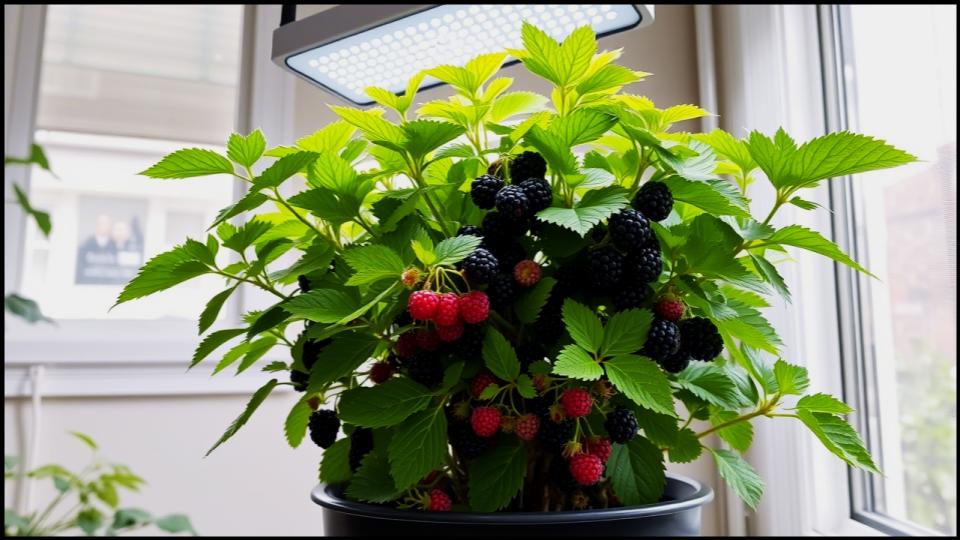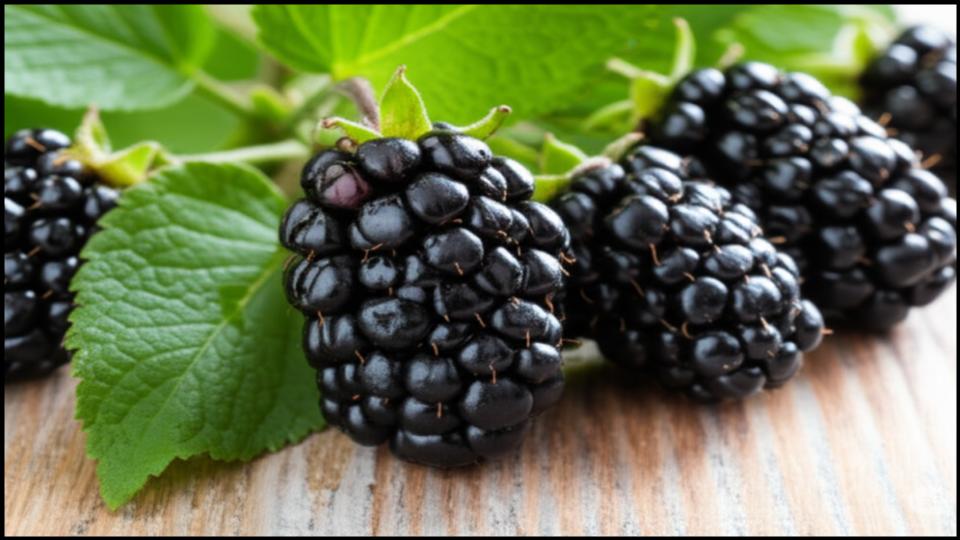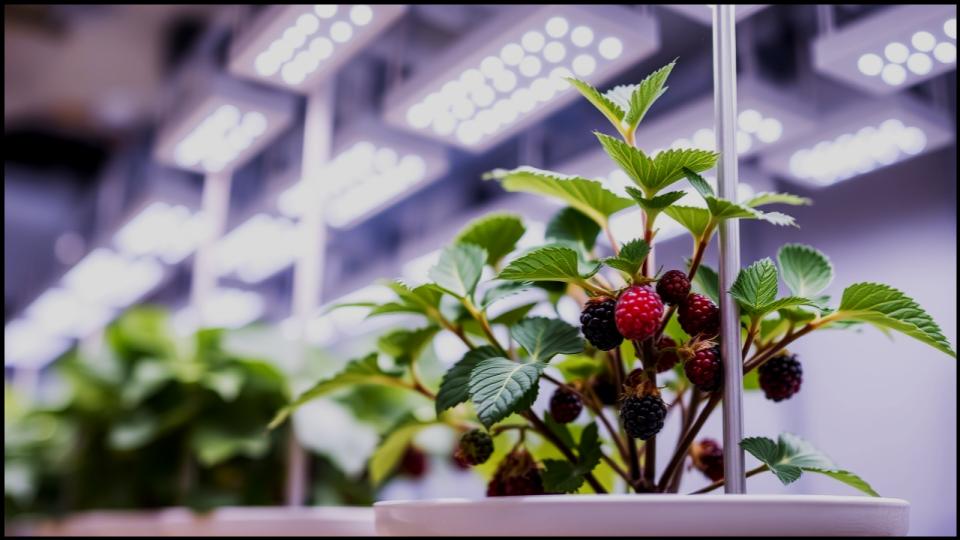Imagine stepping into your kitchen and plucking a perfectly ripe, juicy blackberry, even in the heart of winter. It might sound like a gardener’s fantasy, but with the right techniques, growing blackberries indoors for a continuous supply of fruit is absolutely achievable. This guide will walk you through each step, from selecting the ideal varieties to providing the optimal environment, ensuring you can enjoy the sweet taste of homegrown berries no matter the season. Let’s explore the rewarding world of indoor blackberry cultivation and bring a touch of summer’s bounty into your home, all year long.

Key Takeaways / Quick Tips Box:
Growing Blackberries Indoors: Quick Tips
- Choose the Right Variety: Opt for compact, thornless, and self-pollinating varieties best suited for containers.
- Light is Key: Provide ample supplemental light with grow lights to mimic natural sunlight.
- Proper Pruning: Regular pruning is crucial for managing growth and encouraging fruiting.
- Pollination Assistance: Gently hand-pollinate flowers to ensure fruit set if needed.
- Consistent Care: Maintain consistent watering and fertilization for healthy growth and abundant harvests.

Why Growing Blackberries Indoors Opens a World of Possibilities
For those of us with limited outdoor space, or who simply yearn for the taste of fresh berries year-round, growing blackberries indoors presents a delightful solution. It allows you to bypass seasonal limitations and the challenges of outdoor pests and diseases, offering a controlled environment where your plants can thrive. Beyond the practical benefits, there’s a unique satisfaction in nurturing a fruiting plant indoors, bringing a touch of nature’s abundance right into your home. Plus, the aroma of blackberry blossoms filling the air is a subtle yet wonderful perk.
Choosing the Cream of the Crop: Selecting the Right Blackberry Varieties for Indoors
Not all blackberry varieties are created equal when it comes to indoor cultivation. The key is to select plants that are naturally more compact, thornless for easier handling, and ideally self-pollinating to ensure fruit production without needing a companion plant. Trailing varieties can also be managed with proper trellising or support systems in containers.
In my experience, some excellent choices for growing blackberries indoors include ‘Dwarf Thornless’ (a compact and truly thornless variety), ‘Triple Crown’ (though it can be vigorous, it performs well in larger containers with support), and certain primocane-fruiting varieties like ‘Prime-Ark Freedom’ which fruit on new canes and can offer multiple harvests within a year.
Best blackberry varieties for containers
Setting the Stage: Creating the Ideal Indoor Environment
Just like any plant, indoor blackberries need the right conditions to flourish. This involves paying close attention to light, temperature, humidity, and air circulation.
Light: Mimicking the Sun’s Embrace
Blackberries are sun-loving plants and require at least 6-8 hours of direct sunlight per day to fruit well. Indoors, this often means supplementing with grow lights. Full-spectrum LED grow lights are an excellent choice as they provide the necessary range of light wavelengths and are energy-efficient. Position the lights about 12-18 inches above the plants and use a timer to ensure consistent light exposure. Insufficient light is a common reason why indoor fruiting plants fail to produce, so investing in good quality grow lights is a worthwhile step.
Temperature and Humidity: Keeping Things Comfortable
Maintain a daytime temperature between 70-75°F (21-24°C) and a nighttime temperature of around 60-65°F (15-18°C). Avoid drastic temperature fluctuations. Indoor environments can often be dry, which blackberries don’t particularly love. Aim for a humidity level of 40-50%. You can increase humidity by using a humidifier, placing the pot on a pebble tray filled with water (without the pot directly sitting in the water), or by misting the plants occasionally.
Air Circulation: Preventing Problems
Good air circulation is crucial for preventing fungal diseases. A small oscillating fan can help to gently move the air around your plants.

Planting with Purpose: Choosing Containers and Soil
Selecting the right container and soil mix is fundamental for successful growing blackberries indoors.
Container Considerations: Providing Enough Room to Grow
Choose a container that is at least 10-15 gallons in size to accommodate the root system of a mature blackberry plant. Ensure the pot has adequate drainage holes to prevent waterlogging, which can lead to root rot. Fabric pots are a great option as they promote air pruning of the roots, leading to a healthier root system.
Soil Matters: The Foundation for Healthy Growth
Blackberries prefer well-draining, slightly acidic soil with a pH between 5.5 and 6.5. A good quality potting mix amended with compost and perlite will provide the necessary nutrients and drainage. Avoid using garden soil, as it can be too heavy and may contain pests or diseases. I often add a handful of slow-release organic fertilizer to the potting mix at planting time to provide a steady source of nutrients.
Nurturing Your Indoor Blackberry Patch: Care and Maintenance
Consistent care is essential for a bountiful harvest of indoor blackberries.
Watering Wisely: Finding the Right Balance
Water your blackberry plants when the top inch of soil feels dry to the touch. Water thoroughly until water drains from the bottom of the pot but avoid letting the pot sit in standing water. The frequency of watering will depend on factors like temperature, humidity, and the size of your plant.
Feeding Your Plants: Providing Essential Nutrients
Blackberries are moderate to heavy feeders, especially during their active growing and fruiting periods. Fertilize every 4-6 weeks with a balanced liquid fertilizer or continue to supplement with slow-release organic fertilizer as directed on the product label. Look for a fertilizer with a slightly higher potassium content during flowering and fruiting to encourage berry development.
The Art of Pruning: Encouraging Bushier Growth and Fruiting
Pruning is crucial for managing the size and shape of your indoor blackberry plants and for promoting better fruiting. For primocane-fruiting varieties, you can prune the canes back after they have finished fruiting. For floricane-fruiting varieties (which fruit on two-year-old canes), prune out the canes that have fruited after harvest, and train the new canes that will produce fruit the following year. Regular light pruning to remove any dead or crossing canes is also beneficial.

Pollination Indoors: Giving Nature a Helping Hand
While many of the recommended indoor varieties are self-pollinating, you may still need to assist with pollination to ensure good fruit set. You can do this by gently shaking the flower clusters or using a small, soft brush to transfer pollen from one flower to another. Do this during the mid-morning when the pollen is dry and easily transferable.
Troubleshooting Common Issues: Keeping Your Plants Healthy
Even in a controlled indoor environment, your blackberry plants may encounter a few challenges. Keep an eye out for common pests like aphids or spider mites, and address any infestations promptly with insecticidal soap or neem oil. Ensure good air circulation and avoid overwatering to prevent fungal diseases. Yellowing leaves can indicate overwatering, underwatering, or nutrient deficiencies, so observe your plant closely to diagnose the issue.
Harvesting Your Sweet Rewards: Enjoying Your Indoor Blackberry Bounty
The anticipation of harvesting your own homegrown blackberries is one of the greatest joys of indoor gardening. The berries are typically ready to pick when they are fully colored, slightly soft to the touch, and detach easily from the plant. Harvest regularly to encourage continued fruit production. Enjoy your fresh blackberries in smoothies, desserts, or simply eaten straight from the plant.
Styling Your Indoor Blackberry Plants: Adding Beauty to Your Space
Beyond their delicious fruit, indoor blackberry plants can also add a touch of greenery and visual interest to your home. Train trailing varieties up small trellises or allow them to cascade gracefully from hanging baskets. The lush green foliage and delicate white or pink blossoms can be quite ornamental. Consider placing your plants in sunny windows where they can receive ample light and also be admired.(year-round berry harvest indoors)
Cultivating Sweetness Within Your Walls
Growing blackberries indoors for a nonstop fruit supply is a rewarding endeavor that brings the beauty and bounty of the garden right into your home. By selecting the right varieties, creating an optimal environment, and providing consistent care, you can enjoy the delicious taste of homegrown blackberries throughout the year. Embrace the journey of nurturing these wonderful plants and savor the sweet success of your indoor harvest. Now, with the knowledge you’ve gained, you’re well-equipped to cultivate your own thriving indoor blackberry patch.
